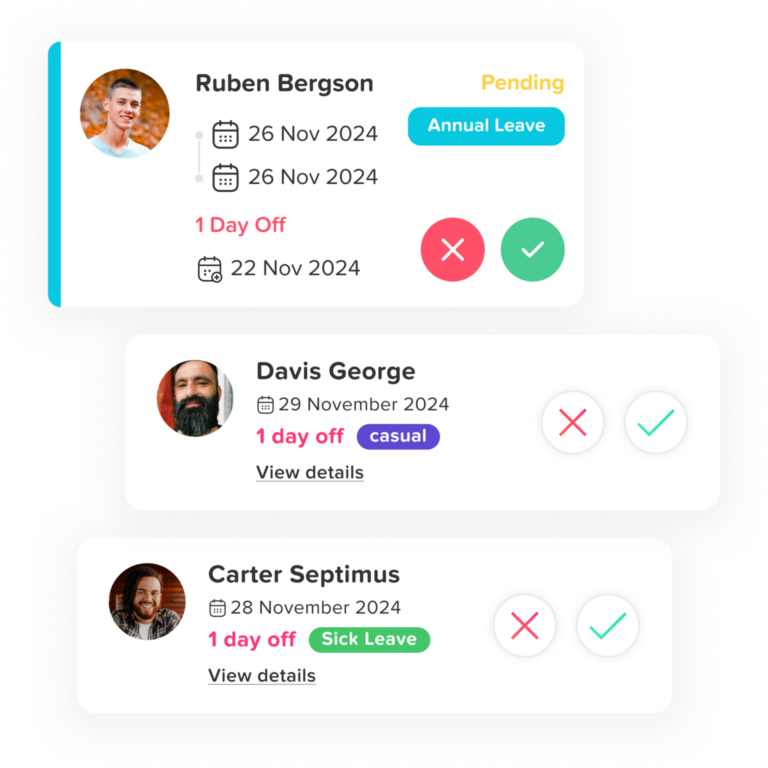Table of Contents
ToggleCompanies are rethinking traditional employment policies to attract and retain top talent. One of the most revolutionary changes in modern HR policies is the adoption of Open Time Off—a flexible, employee-first approach to vacation and leave management.
This article explores the concept of Open Time Off in depth, examining its origins, benefits, challenges, and how companies can implement it effectively. Additionally, we will highlight how a robust leave management solution like Day Off can be pivotal in successfully adopting and managing an Open Time Off policy.
What is Open Time Off?
Open Time Off (OTO), also known as Unlimited PTO (Paid Time Off) or Flexible Vacation Policy, allows employees to take as much time off as needed, provided they meet their performance goals and business responsibilities. Unlike traditional models that allocate a specific number of days for vacation, sick leave, and personal time, Open Time Off puts the onus on the employee and manager to determine appropriate usage.
Core Features:
No strict quota or accrual system
Managerial oversight for coordination and planning
Performance-based evaluation rather than time-based
Inclusive of all types of leave under a single umbrella
This shift represents a more trusting and adult-to-adult relationship between employers and employees.
Origins and Evolution
Open Time Off policies began gaining traction in the early 2010s, particularly among tech companies in Silicon Valley. Giants like Netflix and LinkedIn pioneered the movement, using it to promote a results-oriented work culture. As remote and hybrid work models became more common, especially post-2020, Open Time Off has evolved from a niche perk to a mainstream option for progressive companies.
Its increasing popularity can be attributed to the changing expectations of the workforce. Younger generations value autonomy, flexibility, and transparency—all qualities embedded in an Open Time Off framework.

Benefits of Open Time Off
1. Promotes Trust and Autonomy
Implementing an Open Time Off policy is a statement of confidence in your employees. It signals that you trust them to manage their own workload and time responsibly. This level of trust can significantly enhance job satisfaction, loyalty, and morale.
How Day Off Helps: Day Off offers a transparent, user-friendly interface where employees can view their leave history, make requests, and receive approvals quickly. This smooth and open process reinforces the message that management trusts its people, while still keeping things organized and auditable.
2. Reduces Burnout and Enhances Well-being
By encouraging employees to take time off when they truly need it—whether for travel, mental health, or family emergencies—Open Time Off can dramatically reduce stress and burnout. It fosters a culture where rest and recovery are valued as much as productivity.
How Day Off Helps: Day Off includes smart reminders and analytics that help HR and managers track time-off trends. If an employee hasn’t taken time off recently, the system can nudge them or flag it for managerial attention. This ensures no one slips through the cracks and that well-being stays front and center.
3. Simplifies Leave Management
Traditional PTO systems require complex tracking, carryovers, and legal compliance around payouts. Open Time Off simplifies these logistics by removing accruals and balances from the equation.
How Day Off Helps: Day Off takes this one step further by automating repetitive HR tasks such as leave approvals, calendar syncing, and reporting. HR can customize policies and workflows to suit the team’s needs, while the platform ensures all data is recorded accurately and in real time.
4. Boosts Talent Attraction and Retention
In a competitive job market, offering Open Time Off can be a key differentiator. It appeals especially to high-performing professionals who value outcomes over hours logged. It signals a progressive, employee-centered company culture.
How Day Off Helps: Day Off enhances the onboarding experience by providing new hires with immediate clarity on how the leave policy works. Integration with other HR platforms means candidates are informed upfront about your flexible leave culture, which can positively influence their decision to join.
5. Encourages Better Work-Life Integration
Instead of forcing employees to segment their lives into “work” and “personal,” Open Time Off acknowledges the fluidity of modern life. It enables people to manage caregiving, schooling, travel, and downtime more organically.
How Day Off Helps: Day Off supports work-life harmony by allowing employees to request and manage leave from anywhere, anytime. Whether it’s through the mobile app or web platform, they can plan around their personal lives without the hassle of back-and-forth emails or manual tracking. The calendar view helps coordinate with teammates, reducing friction and overlap.
Challenges and How to Overcome Them
1. Underutilization Due to Ambiguity or Fear
Paradoxically, Open Time Off can lead to fewer days taken because employees fear judgment or lack clarity on what’s acceptable.
Solution with Day Off: Day Off’s reporting tools allow HR to monitor usage and ensure employees are taking adequate time off. Set recommended minimums and track adherence to create a culture that truly supports rest.
2. Inconsistent Managerial Application
Some managers may inadvertently create unequal experiences by approving time off inconsistently.
Solution with Day Off: Standardized approval workflows and notification systems within Day Off ensure consistency across teams and departments.
3. Legal and Compliance Complications
Labor laws in certain jurisdictions require documentation of leave, even under an unlimited model.
Solution with Day Off: All time off is recorded digitally within Day Off, making it easy to produce documentation for audits, compliance checks, and legal purposes.
4. Lack of End-of-Year Payouts
Employees who are accustomed to accruing PTO may view the absence of payouts as a downside of Open Time Off policies.
Solution with Day Off: Communicate clearly through Day Off’s announcement features and FAQs. You can also configure optional “tracked unlimited” policies that simulate accruals for budgeting purposes.
Best Practices for Implementing Open Time Off
Set Clear Expectations
Define how much time off is encouraged (e.g., “take at least 3 weeks per year”).
Use Day Off to set automated nudges if minimums aren’t being met.
Train Managers Thoroughly
Ensure they understand how to approve, plan, and support time off under an Open Time Off framework.
Day Off includes training materials and access controls for manager-level roles.
Lead by Example
Executives and team leads should model the behavior by taking time off themselves.
Use Day Off’s visibility features to show leadership activity and encourage normalization.
Track and Analyze Usage
Use Day Off’s dashboard to visualize patterns, spot burnout risks, and optimize workflows.
Communicate Openly and Frequently
Keep employees informed about the Open Time Off policy’s purpose and their rights.
Day Off allows for custom messaging, policy documentation, and in-app education.
Ready to modernize your leave policy? Visit Day Off to discover how simple and empowering time off management can be with Flexible Time Off at its core.
Frequently Asked Questions (FAQ) About Open Time Off
Q1: Is Open Time Off the same as unlimited vacation?
Not exactly. While “unlimited vacation” is often used synonymously with Open Time Off, the latter is more nuanced. Open Time Off encompasses all types of leave, including sick days, mental health days, and personal time, and is based on mutual trust and performance standards rather than just offering limitless vacation days.
Q2: How does Open Time Off affect team planning and coverage?
Good planning is crucial. Companies should implement clear scheduling practices and use tools like Day Off to manage time off requests, track team availability, and prevent overlap. Proper coordination ensures business continuity while employees enjoy the flexibility.
Q3: What if employees abuse the Open Time Off policy?
Abuse is rare when there’s strong communication and performance accountability. Managers should focus on results and use platforms like Day Off to track leave patterns and identify any red flags early.
Q4: Does Open Time Off mean no holidays are tracked anymore?
No. Public holidays and company-wide breaks are usually still observed. Open Time Off typically applies to additional, discretionary leave and should be managed alongside a holiday calendar, which Day Off can handle seamlessly.
Q5: How do new employees adjust to Open Time Off?
Orientation and onboarding should include clear explanations of how the policy works. With Day Off, you can provide access to documentation, send announcements, and guide new hires through requesting time off with ease.
Q6: Is Open Time Off a fit for every company?
Not always. Flexible Time Off works best in results-oriented cultures and roles that don’t require fixed shift scheduling. However, even companies with more rigid requirements can use a hybrid approach—something Day Off’s flexible configuration supports.
Q7: What metrics should HR track under an Open Time Off policy?
Rather than tracking hours or days accrued, HR should monitor usage frequency, team availability, and correlation with productivity or burnout. Day Off provides these analytics in a user-friendly dashboard.
Q8: Can Open Time Off apply internationally?
Yes, but you need to account for local labor laws. Open Time Off should be adapted regionally to meet compliance standards. Day Off can manage multi-location policies and ensure legal and cultural fit across jurisdictions.
Conclusion
In a world that increasingly values flexibility, well-being, and trust, Open Time Off stands out as a powerful policy for forward-thinking companies. It shifts the conversation from time-tracking to trust-building, from controlling hours to measuring outcomes. Done right, it’s a win-win for both employers and employees.
However, for Flexible Time Off to succeed, it requires thoughtful implementation, clear expectations, and the right tools to support it. That’s where Day Off makes a transformative difference. With automation, transparency, mobile access, and seamless integrations, Day Off empowers organizations to operationalize Open Time Off in a structured yet human-centric way.
Whether you’re just exploring the concept or ready to upgrade your leave management approach, Open Time Off could be the next great evolution in your workplace strategy—and Day Off is the ideal partner to make it happen.
Ready to take the leap? Visit Day Off and empower your team to rest better, work smarter, and thrive together.
